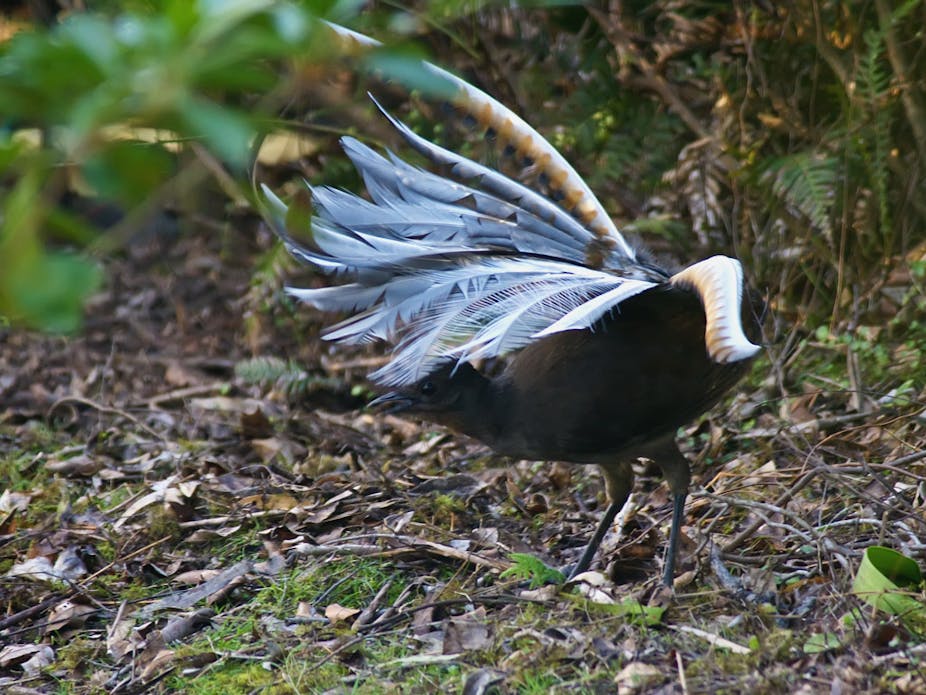The lyrebird is considered one of Australia’s best-known birds — you might recognise them from our 10 cent coin — but do we really know them? Famed for their spectacular courtship display, you may have seen footage of lyrebirds mimicking human noises such as chainsaws and camera clicks.
But do lyrebirds in the wild really mimic chainsaws? Yes, if you search the internet; no, if you read the literature.
Meet the lyrebirds
There are two species of lyrebird in Australia. The superb lyrebird lives in dense forests in Victoria, across the ACT, and into New South Wales and extreme SE Queensland (they have also been introduced into Tasmania).
The lesser-known Albert’s lyrebird resides in a small, inhospitable area of southern Queensland rainforest from Tamborine Mountain to Lamington National Park.
About the size of a pheasant, lyrebirds use their powerful legs and claws to rake leaf litter for worms, grubs, and insects. These shy ground-dwellers have elaborate and cumbersome tails in the shape of a lyre. Their feathers were much in demand by milliners in previous eras.
Aside from their spectacular tail, lyrebirds are notable for their vocal abilities. Feathers and voice come together in their courtship display, when they bring their tail over their body and head, vibrating it as they sing and dance.
Lyrebirds sing most in the winter (which is their breeding season). They sing to both proclaim a territory and to attract females, and these songs are not innate. Like all songbirds, lyrebirds are vocal learners. Male lyrebirds tend to learn their songs and, intriguingly, even their mimicry of other sounds, from older males rather than directly from their mimicked models.
Master mimics
A number of Australian songbirds mimic other species. Biologists have yet to resolve the function of avian mimicry, and likely there is more than a single function.
What is clear, however, is that lyrebirds have a stunning ability to accurately mimic the sounds of the forests they inhabit. Most of their mimicry is of other avian species: calls, songs, wing beats, and beak claps, which they deliver in quick succession.
The avian sound-producing organ is the syrinx. Instead of the usual four pairs of syringeal muscles of other songbirds, lyrebirds have only three pairs. It is not known if this simplification makes them more adept at mimicry, nor is their motivation to mimic entirely clear. There is no evidence to suggest that lyrebirds attempt to fool other species.
While mimicry forms most of their vocal repertoire, lyrebirds also have their own songs and calls. While the “territorial” song can be melodious, the “invitation-display” call sounds mechanical to human ears. Twanging, clicking, scissors-grinding, thudding, whirring, “blick”-ing, galloping — these noisy or metallic sounds are the lyrebirds’ own and not mimicry. Nevertheless, they are often mistaken for that.

The chainsaw myth
From whence comes the myth that lyrebirds in the wild mimic chainsaws and other mechanical sounds?
A likely candidate is David Attenborough’s Life of Birds series. In it, Attenborough peers at the bird (and the camera) from behind a tree, whispering to us about the bird mimicking “sounds that he hears from the forest”. We see compelling footage of a bird imitating a camera’s motor drive, a car alarm, and a chainsaw.
This Attenborough moment is highly popular — but hold on! He fails to mention that two of his three lyrebirds were captives, one from Healesville Wildlife Sanctuary and the other from Adelaide Zoo. This latter individual, Chook, was famed for his hammers, drills, and saws, sounds he reputedly acquired when the Zoo’s panda enclosure was built. Hand-raised from a chick, he was also known to do a car alarm, as well as a human voice intoning “hello, Chook!” He died in 2011, aged 32.
The fact that lyrebirds in captivity mimic human machines and voices with such fidelity should be a substantial enough achievement to warrant our awe.
Back in the wild

There is only one suggested example of imitation of a man-made sound in a lyrebird’s territorial song — wild or captive — that of the “flute lyrebirds” of the New England Tablelands. This extraordinarily complex song consists of flute-like tone colours.
How have we humans made sense of this?
A lyrebird chick was raised in captivity in the 1920s. It mimicked the household’s flute player, learning two tunes and an ascending scale. When released back into the wild, his flute-like songs and timbre spread throughout the Tablelands’ lyrebird population — or so the story goes.
I participate in a research group that is mapping the “flute lyrebird” territory and studying the origins of this story. Our recent article was unable to consolidate the conflicting memories and recorded anecdotes of credible witnesses.
Nevertheless, every winter the rugged, misty rainforests of the New England Tablelands resound with flute-like timbres, contrapuntal overlapping scales, and melodic contours (often with a musical competence exceeding what a human flautist could achieve) that are poles apart from the territorial songs of the rest of the species.
Do wild lyrebirds mimic machinery and the like? While I can imagine that in rare circumstances their vocalisations could reflect the human impact on their environment (and there are such anecdotes), there is no known recording of a lyrebird in the wild mimicking man-made mechanical sounds. Nevertheless, belief in such a phenomenon is now so well established on the internet that it even crops up on official sites.
Read more about the flute lyrebirds here

